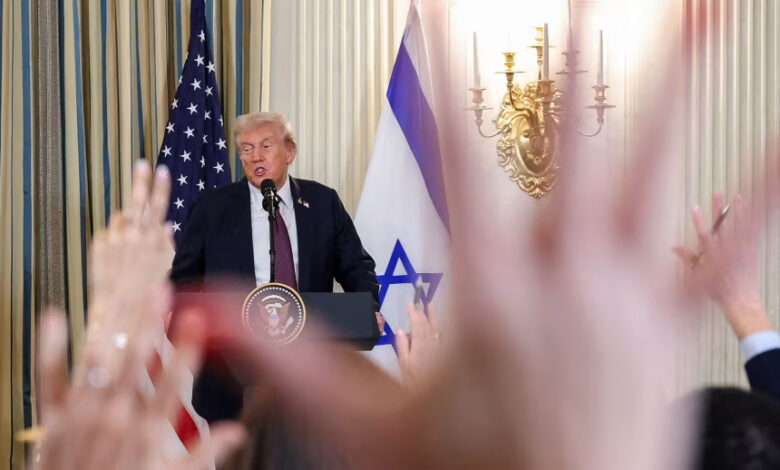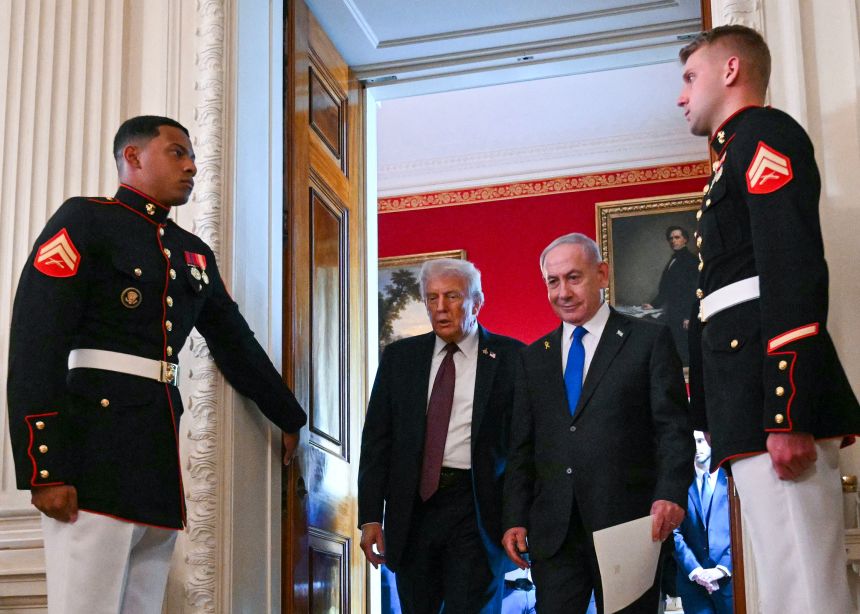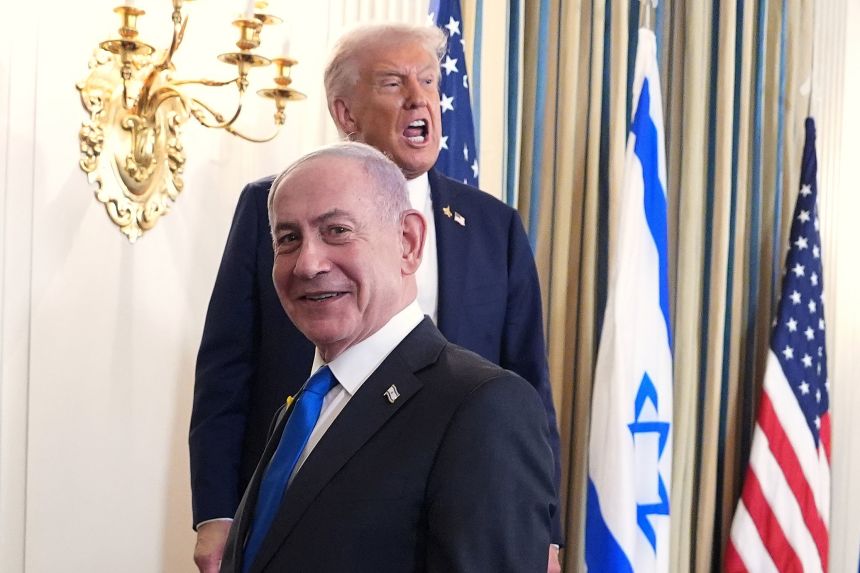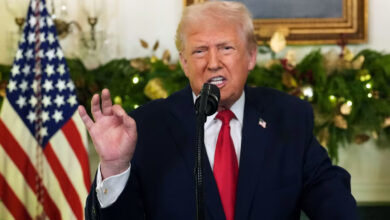
Donald Trump called it “potentially one of the great days ever in civilization.”
Even for a president known for hyperbole, this was setting expectations absurdly high for his new 20-point peace plan for Gaza.
But this is an administration that often treats announcements as world-changing breakthroughs. It’s only got one peacemaking play — expressing extreme optimism designed to bounce rival parties into an agreement.
Still, the humanitarian situation in Gaza is so horrific, and the plight of remaining hostages held by Hamas following the October 7, 2023, terror attacks is so dire, that any hope for ending agonizing human misery should be eagerly grasped.

Trump’s new plan does appear to be the administration’s most substantive, thoughtful and broadly supported effort to end the Gaza war yet. If fully implemented, it in theory offers the promise of a future for Palestinians in the Strip. If it takes hold, it might create space for a process to mediate the Israel-Palestinian conflict.
It’s certainly more realistic than Trump’s previous wild vision of a “Riviera of the Middle East” arising from the rubble of Israel’s onslaught. And its step-by-step approach likely to last many months acknowledges that such a vicious conflict can’t be ended by the kind of shallow, art-of-the-deal trade-offs in which Trump dealt as a real estate mogul.
Trump did forge progress in getting Netanyahu to publicly sign up for a plan that bore clear hallmarks of his recent meetings with top Arab and Muslim leaders.
Yet the Middle East has never lacked peace plans. There’ve been scores of them, sponsored by the US, Europe, the Saudis and other Arab states. But most never come anywhere near implementation, because the region’s tortured history and political opportunism on both sides always intervenes.

This is one reason why Trump’s claim that “we’re at a minimum, very, very close,” to solving “things that have been going on for hundreds of years and thousands of years” is best received with only reserved optimism.
Even if Hamas gets on board, the choreography of a hostage release within the allotted 72 hours would be a heavy lift. And on the intense Gaza battlefield, incidents could explode at any time that either side could use as an excuse to ditch Trump’s peace proposal.
The other cautionary note is one that has also haunted Trump’s other big peace initiative — over Ukraine, which like his Gaza process includes windy claims of imminent breakthroughs and photo ops but failed amid worsening bloodshed.
Trump clearly loves the big moments and gets impatient with the drudgery of diplomacy. But both tracks also reveal a White House that frequently misreads the emotional, historical and political forces driving the protagonists in a conflict that make them less willing to compromise.
The fate of Trump’s new Middle East initiative therefore may depend on these questions:
— Is the president prepared to devote his full focus, energy and seven-days a week attention to solving this most intractable of global conflicts?
— Will he impose the kind of considerable US leverage and personal pressure on a strongman leader that he’s so far been loath to bring to bear on Netanyahu in Israel or Vladimir Putin in Russia?
— And can an administration that keeps getting nowhere with top-down peacemaking create an intricate diplomatic process in the shadows that builds confidence between parties and creates key small wins rather than photo-ops?
Is Trump ready to pressure Netanyahu?

The 20-point peace plan calls for an immediate ceasefire, the release of hostages held by Hamas in a swap for Palestinians in Israeli jails, a staged Israeli withdrawal, the disarmament of Hamas, the demilitarization of Gaza and a transitional government in the Strip led by an outside international body.
The biggest risk is that it could fold almost immediately if Hamas will not agree to a demand to release remaining Israeli hostages, the living, and the dead, within 72 hours of Netanyahu’s endorsement on Monday.
A cynic may argue that this may be exactly the choice that Netanyahu is banking on Hamas not making, after securing Trump’s green light to “finish the job” in Gaza if the radical Islamic terror group does not sign up.
Netanyahu arrived in Washington on Monday more than ever dependent on Trump and the United States, as Israel’s isolation deepens. Countries that offered support and sympathy over the October 7 attacks, the worst mass attack on Jews since the Holocaust, have been alienated by the deaths of tens of thousands of civilians in the Israeli attempt to rout Hamas from Gaza.
There were signs Monday that Trump is upping the pressure on the Israeli leader, after months of turning a blind eye to his operations in Gaza.
Trump argued that while Netanyahu was a warrior, the Israeli people “want to get back to peace. They want to get back to normalization in a true sense.” And while criticizing European nations for unilaterally recognizing a Palestinian state, he seemed to understand their rationale. “They’re really, I think, doing that because they’re very tired of what’s going on for so many decades.”
Trump also got Netanyahu on the phone with the Prime Minister of Qatar, Sheikh Mohammed bin Abdulrahman bin Jassim Al-Thani, and the Israeli leader expressed “regret” for the death of a Qatari solider in an Israeli raid on Hamas negotiators in Doha and for violating Qatari sovereignty this month.
This was an unusual sign of Trump being prepared to use his leverage on Netanyahu. Was it a hint he’d be willing to do so more in the future?
How Netanyahu may be playing Trump

Netanyahu, who like other world leaders understands the power of flattering Trump, offered the president his victory lap.
“I support your plan to end the war in Gaza, which achieves our war aims. It will bring back to Israel all our hostages, dismantle Hamas’ military capabilities, end its political rule and ensure that Gaza never again poses a threat to Israel,” he said.
But Netanyahu’s own history, his skill at finessing US requirements while staying true to his own political goals, and his long record of defying and infuriating American presidents means he’ll be judged by his actions not his words.
That test will begin as soon as he arrives home in Israel. Will he really confront far-right members of his coalition who want to crush Hamas, eject Palestinians from Gaza and annex the West Bank and who will oppose Trump’s plan?
If they won’t budge, would he be bold enough to risk the downfall of his government and fight an election for a mandate based on Trump’s vision?
There’s an alternative, and perhaps more likely scenario.
Netanyahu might have warmly endorsed Trump’s proposal in the White House in the expectation that Hamas could never sign up to it, and that he’d then face no objections to escalating his assault in Gaza. Even if Hamas does agree, Netanyahu might undercut the militant group in order to topple a ceasefire agreement.
Many US observers believe the prime minister, facing personal legal woes and future probes into October 7, sees prolonging the war as a matter of political survival.
And at times, the joint Netanyahu-Trump press appearance on Monday felt more like an ultimatum about what would happen if the hostages aren’t immediately released than an overture to peace.
Trump said he expected a positive response from Hamas. But he added: “If not, as you know, Bibi, you’d have our full backing to do what you would have to do.”
Hamas has tough choices
If Israel is more isolated, so is Hamas. Trump made a great show of reciting the names of all the Arab and Muslim leaders who had backed his plan. He said of Hamas “They’re the only one left. Everyone else has accepted it.”
But Trump’s optimism might be misplaced.
A member of the Hamas political bureau Ghazi Hamad made clear to CNN’s Jeremy Diamond in an interview there are few signs that group is ready to release all 48 remaining hostages or to moderate its position, such as opposing Israel’s demand that it be disarmed. He interpreted Israel’s attempt to assassinate him and other Hamas negotiators in Qatar as a sign that Netanyahu was not serious about peace. And he expressed distrust of Trump and the US team.
And handing over the hostages within 72 hours would force Hamas to give up its prime leverage.
“Unfortunately, this plan is full of mines, huge mines that could undermine even its implementation,” Mustafa Barghouti, co-founder of the Palestinian National Initiative told CNN International. “The biggest mine here is what will Israel do after it gets back its prisoners or hostages? Will Netanyahu reactivate the war? What are the guarantees that he will not do that,” he said.

Another glaring liability of Trump’s plan is that it suffers from a characteristic fault of such initiatives — a lack of input from the Palestinians themselves.
And the idea that Trump would effectively wield de-facto rule over Gaza as the head of an overarching international body called a “Board of Peace” could be a deal breaker for many Palestinians. The board would be supplemented by an apolitical committee of Palestinian technocrats.
Then there’s a proposal for Tony Blair to join the peace board.
The former British Prime Minister has been deeply engaged in the Middle East since entering 10 Downing Street in 1997, and after his 10 year premiership. But he’s best remembered in the region for backing the disastrous US invasion of Iraq. And the idea that a prominent Briton would effectively help rule over Gazans brings prohibitive historic echoes.
“We have been under British colonization already before, we’ve struggled for more than 100 years to be free from that colonization and then the Israeli occupation,” Barghouti said.




